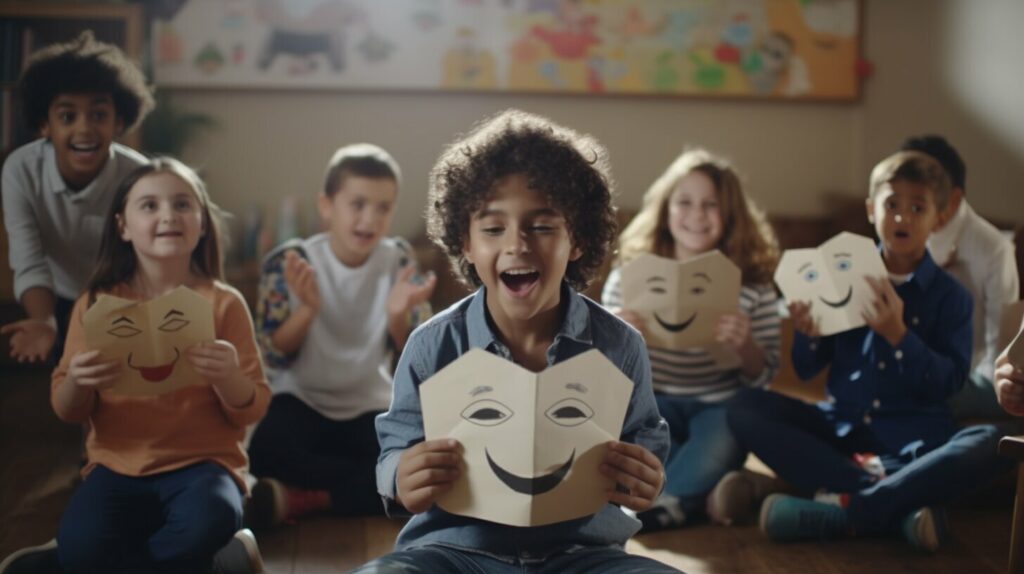Helping children understand and express their feelings is essential for their emotional growth and well-being. However, explaining emotions to a child can be challenging, especially when dealing with complex feelings. Effective communication is key to fostering emotional intelligence in children. In this guide, we will provide you with practical tips on how to explain feelings to a child, create a safe and open environment for emotional expression, and teach emotional self-regulation to your child.
Key Takeaways:
- Effective communication is crucial for fostering emotional intelligence in children.
- Teaching children about emotions is important for their overall well-being.
- Creating a safe and open environment where children can express their emotions is necessary.
- Using age-appropriate language and examples can simplify complex emotions for children.
- Recognizing and validating children’s emotions is essential.
- Empathy and perspective-taking can help children understand others’ emotions.
- Teaching emotional self-regulation is crucial for children’s emotional development.
- Books and media can be useful tools for discussing emotions with children.
- Encouraging emotional expression through art and play can be effective.
- Being a role model for healthy emotional expression is essential for parents and caregivers.
The Importance of Teaching Kids about Emotions
As a parent or caregiver, you play a crucial role in your child’s emotional development. Teaching kids about emotions is essential in helping them develop healthy self-awareness and management skills, which will benefit them throughout their lives.
Children who understand and can communicate their feelings are better equipped to navigate social situations, form healthy relationships, and handle stress. Additionally, research shows that emotional intelligence is linked to academic success, making it even more crucial to prioritize teaching kids about emotions from a young age.
By providing your child with a strong emotional foundation, you can help them build resilience, self-esteem, and overall happiness. So, take the time to talk to your child about emotions and encourage them to express themselves openly, and you will be setting them up for success.
The Importance of Teaching Kids about Emotions
- Helps children develop healthy self-awareness and management skills
- Equips children to navigate social situations with confidence
- Improves academic success
- Builds resilience and self-esteem
- Boosts overall happiness
So, make it a priority to teach your child about emotions. It will not only benefit them in the present but also set them up for a bright future.

Creating a Safe and Open Environment
For children to feel comfortable discussing their emotions, they need to feel safe and supported. As a parent or caregiver, creating a safe and open environment is crucial.
One way to foster this environment is to actively listen to your child. When your child talks about their feelings, listen carefully without interrupting. This shows your child that their emotions are important and valued.
Empathy is also a key component in creating a safe environment. Try to put yourself in your child’s shoes and understand how they are feeling. Let them know that you understand by saying things like “It sounds like you’re feeling sad because…
Encourage your child to express their emotions by letting them know it is okay to feel a certain way. Avoid dismissing their feelings or telling them how they should feel. Instead, validate their emotions by saying things like “It’s completely understandable why you would feel that way.

By creating a safe and open environment for your child, you are helping them develop emotional intelligence and teaching them that their emotions are valid and important.
Using Age-Appropriate Language and Examples
It is important to use age-appropriate language and examples when explaining emotions to children. You don’t want to overload them with complex vocabulary and concepts that they may not fully understand. Simplifying emotions and making them relatable can help children better grasp and communicate their own feelings.
For younger children, you can use visual aids such as picture books and drawings to illustrate emotions. Using colors to represent different emotions can also be helpful. For example, yellow can represent happiness and red can represent anger.
For older children, using real-life examples and discussing how different emotions can manifest in different situations can be effective. You can also encourage them to identify their own emotions by asking open-ended questions such as “How are you feeling?” or “Can you tell me more about that?”
Remember to be patient and understanding when communicating with children about emotions. It may take time for them to fully comprehend and express their feelings. But with the right language and approach, you can help them develop a strong emotional vocabulary and a healthy understanding of their own emotions.

Recognizing and Validating Emotions
One of the most important things you can do when explaining feelings to a child is to recognize and validate their emotions. It is essential to let your child know that you understand and accept their feelings, no matter how intense or confusing they may seem.
When your child expresses an emotion, try to respond with empathy and understanding. For example, if your child is upset because they didn’t get invited to a friend’s party, you could say something like, “I can see that you’re feeling left out and upset. It’s okay to feel that way. Let’s talk about what we can do to make you feel better.”
If your child feels like their emotions are being dismissed or ignored, they may start to bottle up their feelings, which can lead to even bigger emotional outbursts later on.
Remember that all emotions are valid, and it’s normal for children to experience a wide range of feelings. Rather than dismissing their emotions, try to help your child understand and express them in healthy ways.
By recognizing and validating your child’s emotions, you can help them develop a strong sense of emotional intelligence and build a foundation for healthy emotional development.

Empathy and Perspective-Taking
Empathy and perspective-taking play important roles in helping children understand emotions. By showing empathy towards others, children can learn to put themselves in someone else’s shoes and recognize how they might be feeling. Perspective-taking involves taking into account different viewpoints and experiences, which can help children develop a more well-rounded understanding of emotions.
One way to encourage empathy and perspective-taking is by asking open-ended questions, such as “How do you think your friend felt when you didn’t share your toy?” This allows children to consider different emotions and perspectives, and can help them develop a more empathetic outlook.
Another way to develop empathy is through storytelling. Reading books or watching movies that feature characters experiencing a wide range of emotions can help children learn how to recognize and understand different emotions. Encourage your child to think about how the characters might be feeling and why.

Teaching Emotional Self-Regulation
Teaching children how to regulate their emotions is an essential part of helping them understand their feelings. Self-regulation involves developing the ability to manage intense emotions and exercise self-control. By teaching your child how to self-regulate, you are equipping them with valuable life skills that will serve them well in the future.
One strategy you can use to help your child recognize their own emotions is to talk about your own feelings in front of them. By doing this, you are modeling healthy emotional expression and teaching your child that it is okay to feel a wide range of emotions. This can help your child to feel more comfortable expressing their own emotions and lead to a better understanding of the feelings of others.
Another important aspect of teaching self-regulation is helping your child to develop healthy coping mechanisms. You can encourage your child to develop their own coping strategies, such as deep breathing or taking a break to calm down. This can help them learn to manage their emotions in a healthy way and reduce the likelihood of emotional outbursts.
It is important to remember that developing emotional self-regulation skills takes time and practice. Be patient with your child and continue to provide a safe and supportive environment where they feel comfortable talking about their feelings. By doing so, you are helping your child develop important emotional intelligence skills that will stay with them for life.

Using Books and Media to Discuss Emotions
Books and media can be valuable tools when it comes to discussing emotions with children. Stories and characters can help kids identify and understand different emotions in a relatable way. By reading books or watching movies that explore feelings, children can develop empathy and learn how to express their own emotions.
Choose age-appropriate books and media that match your child’s interests and can help them explore their emotions. For young children, picture books like “The Feelings Book” by Todd Parr or “Today I Feel Silly: And Other Moods That Make My Day” by Jamie Lee Curtis can be a great starting point. For older children, novels like “Wonder” by R.J. Palacio or “Out of My Mind” by Sharon M. Draper can provide insight into the experiences of others and help children develop empathy.
When watching movies or TV shows together, use the stories and characters to spark conversations about emotions. Ask your child how they think the characters are feeling and why. Encourage them to express their own emotions and discuss how they would handle similar situations.
Remember, using books and media should be just one tool in discussing emotions with children. It is important to have open and ongoing conversations about emotions and to provide a safe and supportive environment for children to express themselves.

Encouraging Emotional Expression through Art and Play
If you want to help your child express their emotions in a creative and fun way, encourage them to engage in art and play! These activities provide a safe and enjoyable outlet for children to explore their feelings, while also promoting healthy emotional development.
Here are a few ideas to get you started:
- Create an emotions drawing activity, where your child can draw different emotions and talk about why they might feel that way.
- Use playdough or clay to create emotion faces, representing different feelings like happy, sad, angry, and scared.
- Encourage your child to act out different emotions in a game of charades, or create a skit with various emotional scenarios.
Remember, the key is to keep things light and playful, while still giving your child the space and support they need to express themselves. Through art and play, you can help your child develop a healthy relationship with their emotions, and become more confident in communicating their feelings.

Role-Modeling Healthy Emotional Expression
As a parent or caregiver, you play a crucial role in teaching children about emotions and how to express them in healthy ways. But it’s essential to remember that your actions speak louder than your words. Children learn by observation, so it’s important to model positive emotional expression in your own behavior.
Show your child that it’s okay to express your feelings openly and honestly. When you’re feeling sad, angry, or frustrated, share those emotions with your child in an appropriate way. For example, you might say, “I’m feeling frustrated because I can’t find my keys.” This demonstrates that emotions are a natural part of life and that it’s okay to talk about them.
It’s also essential to handle conflicts and disagreements in a healthy way. Avoid yelling, name-calling, or using physical aggression. Instead, model effective communication skills, such as active listening, empathy, and compromise.
Remember: your child is watching and learning from your behavior, so be sure to model the same healthy emotional expression that you want them to adopt.

Conclusion
Congratulations! You have now learned how to explain feelings to a child effectively. Remember that teaching emotions to children is crucial for their emotional and social development. By creating a safe and open environment, using age-appropriate language, recognizing and validating emotions, practicing empathy and perspective-taking, teaching emotional self-regulation, using books and media, encouraging emotional expression through art and play, and being a role model for healthy emotional expression, you can help your child become emotionally intelligent and resilient. By following the tips and strategies outlined in this article, you are empowering your child to identify, express, and manage their feelings, which will ultimately lead to a happier, healthier, and more fulfilling life. Thank you for taking the time to prioritize your child’s emotional well-being. Keep up the great work!Can You Provide a Simple Explanation of Haughty for Children?
Children, would you like a simple guide to explain haughty? Well, being haughty means feeling superior and treating others as if they are less important. It’s like when someone acts snobby or looks down on others. Remember, kindness and respect are essential, so let’s embrace inclusivity instead of being haughty.
How Can I Teach My Child About Passion in a Way They Can Understand?
Teaching children about passion can be done by breaking it down into simple terms. Explaining passion to a child involves helping them discover their interests and guiding them towards activities that bring joy. By encouraging enthusiasm, supporting exploration, and highlighting personal fulfillment, parents can help their child cultivate a deep understanding of what passion means to them.
Can I Use the Same Strategies to Explain Anxiety and Other Feelings to a Child?
Explaining anxiety to a child requires a tailored approach. While strategies used to discuss other emotions may be helpful, anxiety often entails intense fear and worry. Simplifying concepts, using relatable examples, and encouraging open dialogue can foster understanding. Assuring the child that anxiety is common and manageable will help alleviate their concerns.
Can Jealousy be Explained in the Context of Explaining Feelings to a Child?
It can be challenging to explain jealousy to a child, as it encompasses complex emotions. However, gently guiding them to understand that jealousy is a feeling of wanting something someone else has, and that it’s normal to experience it from time to time, can be helpful. Teaching them empathy, gratitude, and emphasizing on their own unique qualities can also mitigate explaining jealousy to a child.
FAQ
Q: Why is teaching kids about emotions important?
A: Teaching kids about emotions is crucial for their overall well-being. Understanding and managing emotions helps children develop healthy coping mechanisms and build emotional intelligence.
Q: How can I create a safe and open environment for my child to express their emotions?
A: Creating a safe and open environment involves actively listening to your child, validating their emotions, and encouraging them to talk about their feelings without judgment.
Q: How can I explain emotions to my child using age-appropriate language and examples?
A: When explaining emotions, it’s important to use simple, relatable language and examples that your child can understand. Make sure to break down complex emotions into simpler terms.
Q: Why is it important to recognize and validate my child’s emotions?
A: Recognizing and validating your child’s emotions helps them feel understood and accepted. It also teaches them that all emotions are valid and normal.
Q: How can I help my child develop empathy?
A: Encourage empathy by discussing others’ emotions and perspectives. Help your child understand how their actions can impact others and teach them to consider different viewpoints.
Q: How can I teach my child to regulate their emotions?
A: Teaching emotional self-regulation involves helping your child recognize and manage their own emotions. Provide strategies for calming down and developing healthy coping mechanisms.
Q: How can books and media help in discussing emotions with my child?
A: Using age-appropriate books and media can make discussing emotions more engaging and relatable for your child. They provide visual representations and stories that can help them understand emotions better.
Q: How can I encourage emotional expression through art and play?
A: Art and play can be powerful tools for emotional expression. Encourage your child to use art materials, engage in role-play, or participate in imaginative play to explore and communicate their feelings.
Q: How can I role-model healthy emotional expression for my child?
A: Being a role model involves demonstrating healthy emotional expression, such as talking about your own feelings, resolving conflicts constructively, and practicing self-care.






